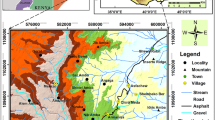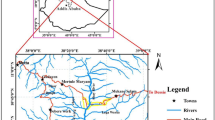Abstract
Landslides that occur due to the rapid motion of a rock-mass are a primary risk in mountainous terrains and are a danger to human life and civil infrastructure. The application of geotechnical engineering methodologies for remedial purposes is to assess unpredictable behavior and the stability of the slope, and for analysis and design. The aim of the study is to quantify the global factor of safety (FOS) and describe a correlative and comparative assessment of the conventional Limit Equilibrium Model as compared with the advanced Numerical Model for the rock slopes of Amiya, Nainital, Uttarakhand in India utilizing Mohr-Coulomb failure criterion. The rock-mass characteristics were determined as a result of an estimation of the physio-mechanical properties of rock and debris from collected field samples with the help of the joint weakening coefficient for limit equilibrium (LE) and the numerical solution. Global FOS estimated by means of stability analysis procedures, such as Swedish slip circle, Ordinary method of slices, Modified Bishop, Janbu method, Finite difference static analysis, Finite element static, and Finite difference dynamic analysis, was found to be 0.65, 1.34, 1.38, 1.29, 1.57, 1.144, and 0.84, respectively. The results helped to deduce that the slope remains substantially stable and failure may only occur in the case of a down slope movement of rock debris (clastic mass of rocks) with a small local/global tremor. Combination of the LE technique and numerical approach (hybrid approach) has been found to be a better method for critical slip surface and FOS determination.


















Similar content being viewed by others
Change history
13 February 2018
In the reference list of the published online paper, the information captured below is wrong: Ramesh, M. V. (2017). Slope stability investigation of Chandmari in Sikkim, Northeastern India. In Workshop 390 on World Landslide Forum (pp. 363–369). Springer, Cham.
References
Bartarya SK, Valdiya KS (1989) Landslides and erosion in the catchments of the Gaula river. Kumaun lesser Himalaya, India. Mt Res Dev 9:405–419
Bieniawski ZT, ed. (1976). Rock mass classification of jointed rock masses. In: Exploration for rock engineering. Balkema, Johannesburg, p 97–106
Bishop AW (1955) The use of the slip circle in the stability analysis of slopes. Geotechnique 1:17
Brady BHG, Brown ET (1993) “Rock mechanics for underground mining.” 2nd edn, pp. 20–24. Chapman and Hall, London
Brideau MA, Pedrazzini A, Stead D, Froese C, Jaboyedoff M, van Zeyl D (2011) Three-dimensional slope stability analysis of south peak, Crowsnest pass, Alberta, Canada. Landslides 8(2):139–158
Budhu M. (2010) Slope stability. Chapter 16, In: Soil mechanics and foundations, 3rd edn. John Wiley and Sons, Inc., New York, p 687–719
Castellanos BA, Brandon TL, VandenBerge DR (2016) Use of fully softened shear strength in slope stability analysis. Landslides 13(4):697–709
Cheng YM, Li L, Liu LL (2015) Simplified approach for locating the critical probabilistic slip surface in limit equilibrium analysis. Nat Hazards Earth Syst Sci 15(10):2241–2256
Coduto DP, Kitch WA, Ronald YM-C (2011) “Geotechnical engineering: principles & practices”, 2nd ed. Hall, Prentice
Cundall PA. (1976). Explicit finite difference methods in Geomechanics in numerical methods in engineering. (Proceedings of the EF Conference on ‘Numerical Methods in Geomechanics’) (Blacksburg, Virginia, June 1976), Vol. 1, p 132–150
Fellenius W. (1936) Calculation of the stability of earth dams. Proceedings of the Second Congress on Large Dams, vol. 4, pp 445–463
Frizzell EM, Watts CF (1988). Back analysis of plane and wedge rock slope failures using microcomputer programs. Proceedings of the Society of Mining Engineers/American Institute of Mining Engineers Annual Meeting, Phoenix, AZ
Ishii Y, Ota K, Kuraoka S, Tsunaki R (2012) Evaluation of slope stability by finite element method using observed displacement of landslide. Landslides 9(3):335–348
ISRM (1979) Suggested methods for determining uniaxial compressive strength and deformability of rock materials. Int J Rock Mech Min Sci 16:135–140
Janbu N (1957). Earth pressures and bearing capacity calculations by generalised procedure of slices. Proceedings of the 4th International Conference on ‘Soil Mechanics and Foundation Engineering’, London, 2, p 207–212
Kainthola A, Singh PK, Wasnik AB, Sazid M, Singh TN (2012) Finite element analysis of road cut slopes using Hoek & Brown Failure Criterion. IJEE 5(5):1100–1109
Kainthola A, Verma D, Thareja R, Singh TN (2013) A review on numerical slope stability analysis. Int J Scie Eng Technol Res 2(6):1315–1320
Kumar D, Thakur M, Dubey CS, Shukla DP (2017) Landslide Susceptibility Mapping & Prediction using support vector machine for Mandakini River basin, Garhwal Himalaya. India, Geomorphology
Li L, Cheng YM, Chu XS (2013) A new approach to the determination of the critical slip surfaces of slopes. China Ocean Engineering 27(1):51–64
Monjezi M, Singh TN (2000) Slope instability in an opencast mine. Coal International 8:145–147
Moudabel OAM (2013) Slope stability case study by limit equilibrium and numerical methods. Oklahoma State University, Stillwater
Namdar A, Khodashenas Pelko A (2010) Experimental, analytical and theoretical slope stability analysis with different materials and methods. Boletín de Ciencias de la Tierra 27:71–78
Niu WJ (2014a) Determination of slope safety factor with analytical solution and searching critical slip surface with genetic-traversal random method. ScientificWorldJournal 950531
Pant PD, Khayingshing L (1999) Malpa rockfalls of 18th august 1998 in northeastern Kumaun Himalaya. Geol Soc India 54:415–420
Rabie M (2014) Comparison study between traditional and finite element methods for slopes under heavy rainfall. HBRC 10:160–168
Ramesh MV (2017) Slope stability investigation of Chandmari in Sikkim, northeastern India. In workshop on world landslide forum (pp. 363–369). Springer, Cham
Sarkar K, Singh TN, Verma AK (2010) A numerical simulation of landslide prone slope in Himalayan region–a case study. Arab J Geosci. https://doi.org/10.1007/s12517-010-0148-8
Sarma SK (1975) Seismic stability of earth dams and embankments. Geotechnique 25:743–761
Shen H, Herbert K, Muntazir AS, Abdelazim I (2012) Slope stability analysis based on the integration of GIS and numerical simulation. Autom Constr 26:46–53
Shukla UK, Pant CC (1996) Facies analysis of the late Proterozoic Nagthat formation, Nainital Hills, Kumaun lesser Himalaya. Geol Soc Ind 47:431–445
Singh RP, Dubey CS, Singh SK, Shukla DP, Mishra BK, Tajbakhsh M et al (2013) A new slope mass rating in mountainous terrain, Jammu and Kashmir Himalayas: application of geophysical technique in slope stability studies. Landslides 10(3):255–265
Singh TN, Verma AK (2007). Evaluating the slope instability of Amiya Slide. In: Eberhardt E, Stead D, Morrison T (eds) Rock Mechanics Meeting Society’s challenges and demands. Taylor and Francis, London, p 993–998
Singh TN, Verma AK (2009) Stress response around fracture surface under uniaxial loading. Earth Science India 2:148–159
Singh TN, Verma AK, Sarkar K (2010). Static and dynamic analysis of a landslide, geomatics. Natural hazards and risk. 1:4, 323–338, https://doi.org/10.1080/19475705.2010.521354
Singh TN, Verma AK, Singh V, Sahu A (2004) Slake durability study of shaly rock and its predictions. International Journal of Environmental Geology 47:246–252
Spencer E (1967) A method of analysis of the stability of embankments assuming parallel interslice forces. Geotechnique 17:11–26
Susan G.G. (1987). An examination of search routines used in slope stability analyses [thesis for MS]. The University of Arizona, Tucson, p 1–99
Thiebes B, Bell R, Glade T, Jäger S, Mayer J, Anderson M, Holcombe L (2014) Integration of a limit-equilibrium model into a landslide early warning system. Landslides 11(5):859–875
Valdiya KS (1988) Geology and natural environment of Nainital hills. Gyanodaya Prakashan, Nainital 8:300
Verma AK, Singh TN (2010a) Assessment of tunnel instability–a numerical approach. Arab J Geosci 3:181–192
Verma AK, Singh TN (2010b) Modeling of a jointed rock mass under triaxial conditions. Arab J Geosci 3:91–103
Wen-Jie Niu (2014b). Determination of slope safety factor with analytical solution and searching critical slip surface with genetic-traversal random method. ScientificWorldJournal. 2014:950531. https://doi.org/10.1155/2014/950531
Author information
Authors and Affiliations
Corresponding author
Rights and permissions
About this article
Cite this article
Kumar, N., Verma, A.K., Sardana, S. et al. Comparative analysis of limit equilibrium and numerical methods for prediction of a landslide. Bull Eng Geol Environ 77, 595–608 (2018). https://doi.org/10.1007/s10064-017-1183-4
Received:
Accepted:
Published:
Issue Date:
DOI: https://doi.org/10.1007/s10064-017-1183-4




